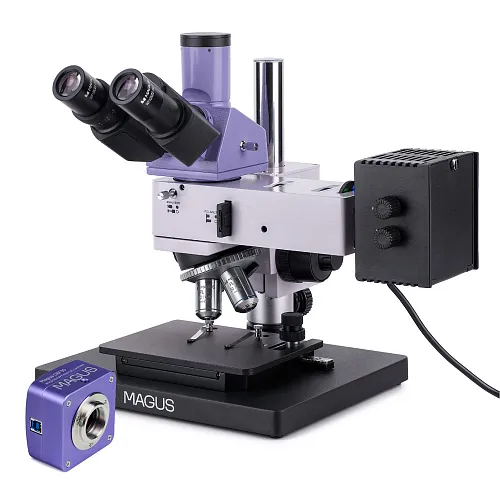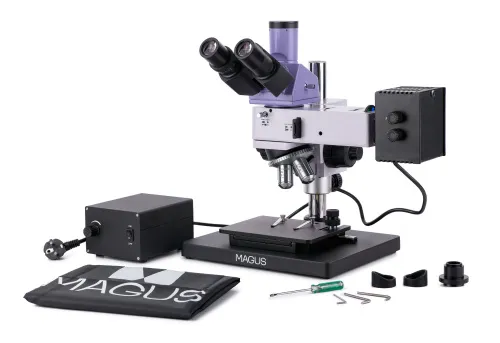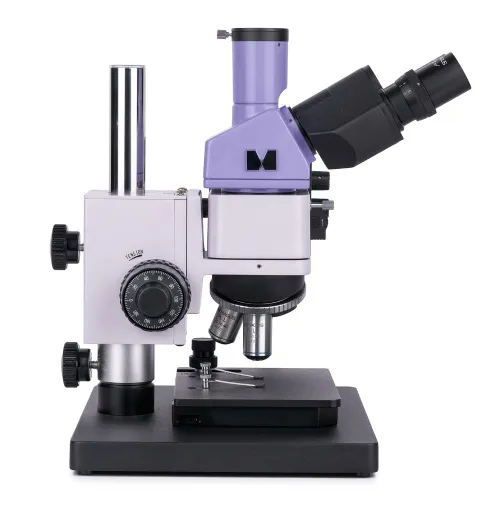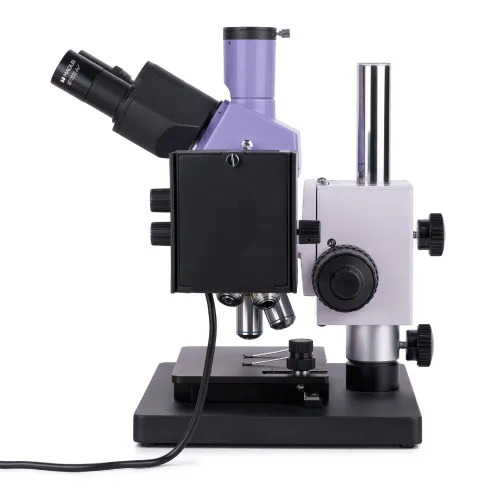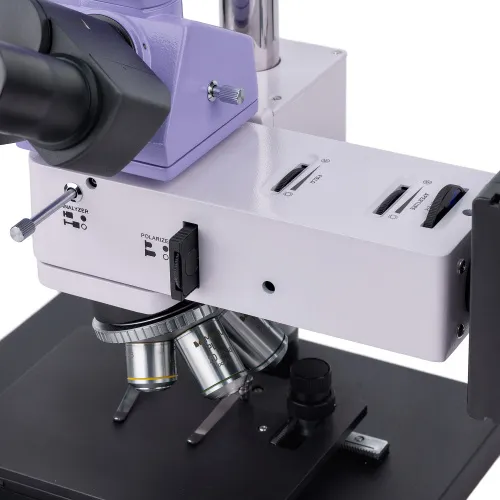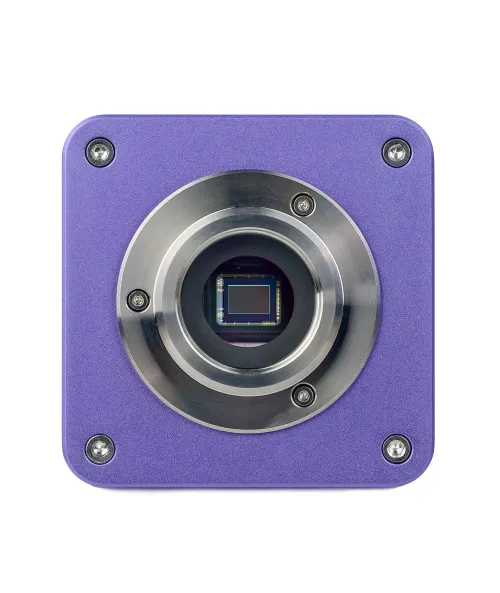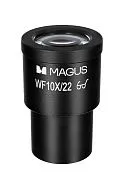MAGUS Metal D630 Metallurgical Digital Microscope
With a camera. Magnification: 50–500х. Compact microscope stand, trinocular head, plan achromatic objectives, 30W halogen reflected light illuminator
| Product ID | 83028 |
| Brand | MAGUS |
| Warranty | 5 years |
| EAN | 5905555018331 |
| Package size (LxWxH) | 39x37x73 cm |
| Shipping Weight | 20.1 kg |
The MAGUS Metal 630 metallurgical reflected light microscope is used to examine the microstructure of opaque objects of any height and size. The objects of study are metals, alloys, semiconductors, and paint coatings. Available microscopy techniques: brightfield and polarized light. One of the advantages of the microscope is its compact size, making it ideal for laboratories with limited working and storage space. MAGUS Metal 630 microscope is an excellent choice for industries in various sectors, research centers, and university departments.
Digital camera
The MAGUS CBF30 Digital Camera enables you to take photographs and shoot video through a microscope, edit the resulting files, organize presentations, and make linear and angular measurements of objects (after correct calibration).
The device is designed to work on microscopes using the brightfield method and 4x, 10x, 20x, and 40x objectives.
The 6.3MP sensor enables you to shoot bright and detailed photos and videos at a maximum resolution of 3072x2048px. If necessary, the resolution can be lowered to 1536x1024px. However, this will not affect the frame rate, which will remain at 59fps, thereby ensuring smooth frame transitions without jerkiness or delays.
The SONY Exmor backlit color CMOS sensor enables you to use the camera even in low-light conditions. The image will remain readable and bright. Using an adapter with a magnification from 0.5x to 0.75x will provide the clearest possible image without distortion.
Optics
The optics of the microscope are infinity-corrected. The trinocular tube that is used for mounting the camera is located vertically. The light beam can be directed either to the eyepieces or into the trinocular tube. The camera is not included in the basic configuration. It is comfortable to work with this microscope for long hours because the binocular head is 30° inclined. Diopter correction is provided on the left eyepiece to adjust the optics to the user’s eyesight.
There are 5 slots in the revolving nosepiece. The kit includes 4 plan achromatic objectives. When they are installed, there is one slot left for installing an optional one. The objectives with long working distance are designed for brightfield microscopy.
Illumination
The microscope only uses reflected light illumination. The illumination system includes a polarization device, an aperture diaphragm, and a field diaphragm. Light source: 30W halogen bulb. Its light is comfortable for the eyes, and so it does not contribute to eye fatigue. The diaphragm and light source can be centered, and a Köhler illumination setup is available. There are color filters.
Stage and focusing mechanism
The stand and focusing mechanism of the unique design provide two advantages: compact size and the possibility to observe samples of any height. The microscope can be easily placed on laboratory furniture with a maximum height of 40cm. A two-axis stage is used to examine small specimens. The focusing is adjusted by rotating the coaxial coarse and fine focusing knobs located on both sides of the stand. The mechanisms operate smoothly and accurately. Coarse tension adjustment can also be adjusted.
Accessories
The microscope can be upgraded with optional accessories: long working distance objectives, eyepieces, digital camera, calibration slides.
Key features of the microscope:
- No restrictions on the sample height and size
- Trinocular head with a trinocular tube for mounting a digital camera and with a 100:0 and 0:100 beam splitter
- 30W halogen bulb with warm light for working in reflected light using brightfield and polarization microscopy techniques
- Color filters, option to set up Köhler illumination, light source, and field and aperture diaphragms that can be centered
- Compact stand for mounting the microscope on small furniture
- Multiple optional accessories
Key features of the camera:
- Recommended for use with low magnification objectives
- Color light-sensitive sensor for clear images even in low light conditions
- Frame rate of 59fps, which is enough for the observation of moving objects or fast-moving processes
- The kit includes software that fully ensures the functionality of all the camera features and, consequently, a “quick start”
- Reliable USB3.0 interface for high data transfer speeds
- Resolution adjustment so that you can choose the option that suits you the best at any given moment
The kit includes:
- MAGUS CBF30 Digital Camera (digital camera, USB cable, installation CD with drivers and software, user manual and warranty card)
- Stand with focusing mechanism, stage and revolving nosepiece
- Reflected light illuminator with a lamphouse
- Trinocular head
- Infinity plan achromatic objective: PL L5x/0.12 WD 26.1mm
- Infinity plan achromatic objective: PL L10х/0.25 WD 20.2mm
- Infinity plan achromatic objective: PL L20х/0.40 WD 8.80mm
- Infinity plan achromatic objective: PL L50х/0.70 WD 3.68mm
- Eyepiece 10x/22mm with long eye relief (2 pcs.)
- C-mount adapter 1x
- Hex key wrench
- Base with a power input
- Power cord
- Reflected light illuminator power cord
- Dust cover
- User manual and warranty card
Available on request:
- 10x/22mm eyepiece with a scale
- 12.5x/14mm eyepiece (2 pcs.)
- 15x/15mm eyepiece (2 pcs.)
- 20x/12mm eyepiece (2 pcs.)
- 25x/9mm eyepiece (2 pcs.)
- Infinity plan achromatic objective: PL L40х/0.60 WD 3.98mm
- Infinity plan achromatic objective: PL L60x/0.70 WD 2.08mm
- Infinity plan achromatic objective: PL L80x/0.80 WD 1.25mm
- Infinity plan achromatic objective: PL L100x/0.85 (dry) WD 0.40mm
- Calibration slide
| Product ID | 83028 |
| Brand | MAGUS |
| Warranty | 5 years |
| EAN | 5905555018331 |
| Package size (LxWxH) | 39x37x73 cm |
| Shipping Weight | 20.1 kg |
| Microscope specifications | |
| Type | light/optical, digital, metallurgical |
| Microscope head type | trinocular |
| Head | Siedentopf |
| Head inclination angle | 30 ° |
| Magnification, x | 50 — 500 |
| Magnification, x (optional) | 50–1000/1250/1500/2000/2500 |
| Eyepiece tube diameter, mm | 30 |
| Eyepieces | 10х/22mm, eye relief: 10mm (*optional: 10x/22mm with scale, 12.5x/14; 15x/15; 20x/12; 25x/9) |
| Objectives | infinity plan achromatic: PL L5x/0.12, PL L10x/0.25, PL L20x/0.40, PL L50x/0.70; parfocal distance 45mm (*optional: PL L40x/0.60, PL L60x/0.70, PL L80x/0.80, PL L100x/0.85 (dry)) |
| Revolving nosepiece | for 5 objectives |
| Working distance, mm | 26.1 (5x); 20.2 (10x); 3.98 (40x); 2.08 (60x); 8.80 (20x); 3.68 (50x); 1.25 (80x); 0.40 (100x) |
| Interpupillary distance, mm | 48 — 75 |
| Stage, mm | 185x140 |
| Stage moving range, mm | 35/30 |
| Stage features | two-axis mechanical stage; microscope base size: 300x240 mm |
| Eyepiece diopter adjustment, diopters | ±5 (on the left tube) |
| Diaphragm | built-in aperture and field |
| Focus | coaxial, coarse (with coarse focusing tension adjustment) and fine (0.002 mm) |
| Illumination | halogen |
| Brightness adjustment | ✓ |
| Power supply | 220±22V, 50Hz, AC network |
| Light source type | 12V/30W |
| Light filters | green, blue, yellow, matt |
| Operating temperature range, °C | 5...+35 |
| Additional | built-in analyzer and removable polarizer |
| User level | experienced users, professionals |
| Assembly and installation difficulty level | complicated |
| Application | metallurgical |
| Illumination location | upper |
| Research method | bright field, polarization |
| Pouch/case/bag in set | dust cover |
| Camera specifications | |
| Sensor | SONY Exmor CMOS |
| Color/monochrome | color |
| Megapixels | 6.3 |
| Maximum resolution, pix | 3072x2048 |
| Sensor size | 1/1.8" (7.37x4.92mm) |
| Pixel size, μm | 2.4x2.4 |
| Light sensitivity | 425mV at 1/30s |
| Signal/noise ratio | 0.15mV at 1/30s |
| Exposure time | 0.02ms–15s |
| Video recording | ✓ |
| Video recording | yes |
| Frame rate, fps at resolution | 59@1536x1024, 59@3072x2048 |
| Place of installation | trinocular tube, eyepiece tube instead of an eyepiece |
| Image format | *.jpg, *.bmp, *.png, *.tif |
| Video format | output: *.wmv, *.avi, *.h264 (Windows 8 and later), *h265 (Windows 10 and later) |
| Spectral range, nm | 380–650 (built-in IR filter) |
| Shutter type | ERS (electronic rolling shutter) |
| White balance | automatic, manual |
| Exposure control | automatic, manual |
| Software features | brightness, exposure time, image size |
| Software | MAGUS View |
| Output | 5Gb/s, USB 3.0 |
| System requirements | Windows 8/10/11 (32bit and 64bit), Mac OS X, Linux, up to 2.8GHz Intel Core 2 or higher, minimum 2GB RAM, USB 3.0 port, CD-ROM, 17" or larger display |
| Mount type | C-mount |
| Body | solid aluminum |
| Camera power supply | DC, 5V, from computer USB port; a 12V, 3A adapter for Peltier element |
| Camera operating temperature range, °С | -10...+50 |
| Operating humidity range, % | 30 — 80 |
and downloads
We have gathered answers to the most frequently asked questions to help you sort things out
Find out why studying eyes under a microscope is entertaining; how insects’ and arachnids’ eyes differ and what the best way is to observe such an interesting specimen
Read this review to learn how to observe human hair, what different hair looks like under a microscope and what magnification is required for observations
Learn what a numerical aperture is and how to choose a suitable objective lens for your microscope here
Learn what a spider looks like under microscope, when the best time is to take photos of it, how to study it properly at magnification and more interesting facts about observing insects and arachnids
This review for beginner explorers of the micro world introduces you to the optical, illuminating and mechanical parts of a microscope and their functions
Short article about Paramecium caudatum - a microorganism that is interesting to observe through any microscope

